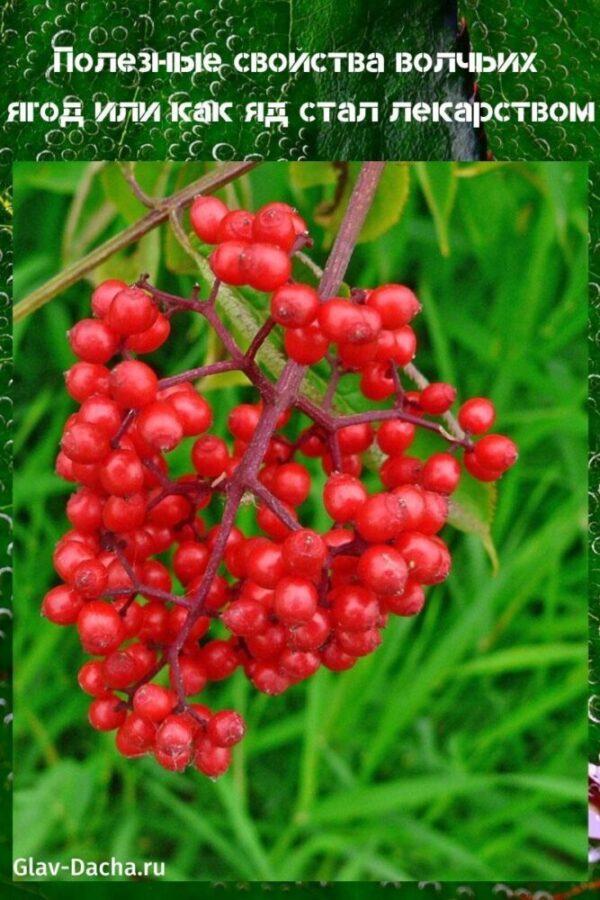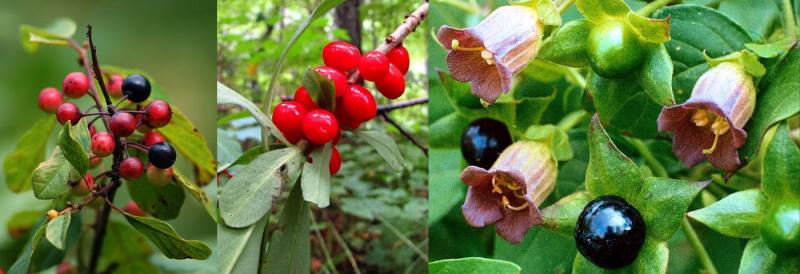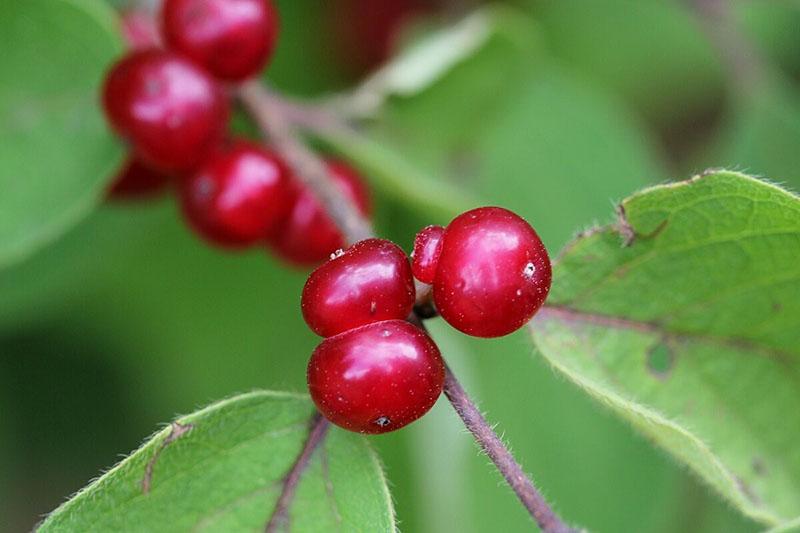Useful properties of wolf berries or how poison became a medicine
 The great alchemist and physician from Switzerland Paracelsus said: "Everything is poison, everything is a medicine, both are determined by the dose." Therefore, considering the beneficial properties of wolf berries, this important factor must be taken into account. The wolfberry is a highly poisonous plant. Several berries (5-6 pcs.) Can kill a person, and the heady scent of bush flowers causes a severe headache. However, in the correct proportions, the poisonous fruits have anti-inflammatory, antiseptic and laxative effects. But before you learn all the intricacies of traditional medicine, you need to get to know the unique plant better.
The great alchemist and physician from Switzerland Paracelsus said: "Everything is poison, everything is a medicine, both are determined by the dose." Therefore, considering the beneficial properties of wolf berries, this important factor must be taken into account. The wolfberry is a highly poisonous plant. Several berries (5-6 pcs.) Can kill a person, and the heady scent of bush flowers causes a severe headache. However, in the correct proportions, the poisonous fruits have anti-inflammatory, antiseptic and laxative effects. But before you learn all the intricacies of traditional medicine, you need to get to know the unique plant better.
Description first


There are several versions of the origin of the name "wolfberry". Wolves in Russia were personified with evil and treachery. Therefore, this name was assigned to these beautiful fruits with a taste of death. Others believe that the wolves ate these berries.
Belladonna (belladonna)
 Perennial from the Solanaceae family. The herbaceous plant grows up to 2 m. Stems with light purple pubescence are covered with dense ovoid leaves. The flowers are of a dirty purple hue with striking veins. Lonely berries of a charcoal black color with a glossy sheen are located in star-shaped axils.
Perennial from the Solanaceae family. The herbaceous plant grows up to 2 m. Stems with light purple pubescence are covered with dense ovoid leaves. The flowers are of a dirty purple hue with striking veins. Lonely berries of a charcoal black color with a glossy sheen are located in star-shaped axils.
Privet
 A shrub or small deciduous tree reaches a height of 5 m. The dark green foliage is lanceolate. Snow-white inflorescences are paniculate bunches on which ovaries are formed. The fruit is also a deep black shade with a shiny skin.
A shrub or small deciduous tree reaches a height of 5 m. The dark green foliage is lanceolate. Snow-white inflorescences are paniculate bunches on which ovaries are formed. The fruit is also a deep black shade with a shiny skin.
The danger to humans is not only the fruits, but also the leaves of the culture.
Common honeysuckle
 The shoots of the shrub are gray-brown and slightly pubescent. The green foliage with a slight burgundy tint is quite elongated and resembles an ellipse. Below it has a lighter color. The buds are collected in inflorescences of 2-4 pcs. The dark red (ruby) fruits are flattened at the poles. They have a funnel-shaped formation in the upper part.
The shoots of the shrub are gray-brown and slightly pubescent. The green foliage with a slight burgundy tint is quite elongated and resembles an ellipse. Below it has a lighter color. The buds are collected in inflorescences of 2-4 pcs. The dark red (ruby) fruits are flattened at the poles. They have a funnel-shaped formation in the upper part.
The beneficial properties of wolf berries make it possible to use honeysuckle as a laxative or emetic. In addition, special poultices speed up the wound healing process. In addition to the antiseptic effect, the plant also has a diuretic.
Dereza ordinary
 Tibetan barberry is not actually poisonous. The nightshade shrub grows up to 3.5 m. Shoots are covered with small thorns. The leaves, like all representatives of the "wolfberry" group, are elliptical. During flowering, the plant is covered with many purple or lilac flowers that resemble bells. The fruiting period lasts from May to October. The berries are similar to barberry: elongated (10-15 mm) and carmine-red.
Tibetan barberry is not actually poisonous. The nightshade shrub grows up to 3.5 m. Shoots are covered with small thorns. The leaves, like all representatives of the "wolfberry" group, are elliptical. During flowering, the plant is covered with many purple or lilac flowers that resemble bells. The fruiting period lasts from May to October. The berries are similar to barberry: elongated (10-15 mm) and carmine-red.
The Chinese call these fruits goji berries. Used to normalize blood pressure, as well as improve vision. They are powerful antioxidants.
Buckthorn fragile
 Joster brittle (another name) is a tree-like shrub. It grows up to 7 m.The brown trunk and branches are smooth, but covered with many transversely elongated lentils. Lanceolate foliage is large enough (4-10 cm) and slightly indented along the edges. In the axils of the leaves, bundle inflorescences are hidden. The buds bloom in late April and take on a pale green hue. Closer to August, black knuckles with a glossy overflow appear on the shoots.
Joster brittle (another name) is a tree-like shrub. It grows up to 7 m.The brown trunk and branches are smooth, but covered with many transversely elongated lentils. Lanceolate foliage is large enough (4-10 cm) and slightly indented along the edges. In the axils of the leaves, bundle inflorescences are hidden. The buds bloom in late April and take on a pale green hue. Closer to August, black knuckles with a glossy overflow appear on the shoots.
In official medicine, alder buckthorn bark is used. An extract is obtained from it or a decoction is prepared as a laxative or anti-hemorrhoid.
Wolf bast
 The most famous representative of wolf berries. Common daphne (deadly) is also called daphne in accordance with its Latin name. The evergreen shrub reaches a height of 1.5 m. The rich green elliptical leaves with gloss resemble laurel foliage. What a wolf's bast looks like is shown in the photo. Last year's shoots are covered with bright scarlet berries, which in early spring were pink flowers in the form of stars. Fruits are arranged in bunches or single specimens. Drupes have a slightly oblong shape.
The most famous representative of wolf berries. Common daphne (deadly) is also called daphne in accordance with its Latin name. The evergreen shrub reaches a height of 1.5 m. The rich green elliptical leaves with gloss resemble laurel foliage. What a wolf's bast looks like is shown in the photo. Last year's shoots are covered with bright scarlet berries, which in early spring were pink flowers in the form of stars. Fruits are arranged in bunches or single specimens. Drupes have a slightly oblong shape.
Why is a wolf's bast dangerous for humans? The berries cause severe poisoning, which can lead to death (cardiac arrest). The scent of flowers and vapors of the crushed bark strongly irritate the nasal / throat mucous membrane.

Official medicine prohibits the use of wolfberry for medicinal purposes. Still, folk healers use it to prepare external medicinal:
- ointments;
- compresses;
- tinctures.
Such remedies are recognized as effective for arthritis, bronchitis (colds) and neuralgia, since they have a strong warming effect. It is worth making sure that the mixture does not irritate the skin.
Useful properties of wolf berries, or rather wolf bast
 The composition of the berries, leaves and bark of the deadly wolfberry contains dangerous poisonous substances. It is coumarins (daphnine glycoside) and diterpenoids (the most famous is meserin resin), getting into the bloodstream, destroy the structure of tissues. These substances attack the mucous membrane and also cause severe bleeding. Despite such a negative effect on the human body, the wolf's bast is very widely used in folk medicine.
The composition of the berries, leaves and bark of the deadly wolfberry contains dangerous poisonous substances. It is coumarins (daphnine glycoside) and diterpenoids (the most famous is meserin resin), getting into the bloodstream, destroy the structure of tissues. These substances attack the mucous membrane and also cause severe bleeding. Despite such a negative effect on the human body, the wolf's bast is very widely used in folk medicine.
The plant is used as such means:
- laxative;
- anticonvulsant;
- sleeping pills;
- pain reliever;
- antibacterial;
- antineoplastic;
- anticoagulant.

The wolf is able to induce appetite by eating one dried berry once a day. In addition, this therapy is useful for chronic fatigue.
A properly prepared drug in compliance with dosages accurate to the milligram will help the patient cope with severe pain during:
- rheumatism;
- gout;

- neuralgia;
- radiculitis.
Children, pregnant and breastfeeding women are prohibited from resorting to wolfberry treatments.
Moreover, each patient should carefully monitor their health. At the first signs of poisoning (upset stomach / intestines, urine with blood), they urgently seek medical help.
Some healers prescribe ointments for the bite of a snake or rabid animal. Wolfberry tincture is useful as an anti-cancer medicine (treatment or prevention).
Infusions are made from the bark, as well as decoctions that help with:
- epilepsy;

- tuberculosis;
- dysentery;
- jaundice

Since wolfberry is a very poisonous plant, from root to fruit, it is imperative to consult a doctor when including it in therapy. The collection of all parts of the culture is carried out only with protective gloves, and also at the right time. The fruits are harvested in July-August and then dried in separate chambers at low temperatures. Then there is no risk that the beneficial properties of wolf berries will be lost.
The bark is cut in strips in early spring before budding begins. The drying process is carried out in dark rooms with very good ventilation.
Recipes from the archives of folk healers
 A decoction of wolf bast flowers is used internally, 5-6 drops 3 times a day. The drug is prepared using 2 g of dried daphne flowers and 20 ml of water. The composition is boiled over low heat. After cooling, the infusion is brought to a volume of 250 ml. In addition, inflorescences are often ground into a powder mass. The resulting mixture is used for severe toothache. A small amount of the product is rubbed into the gums, followed by rinsing the mouth with boiled water.
A decoction of wolf bast flowers is used internally, 5-6 drops 3 times a day. The drug is prepared using 2 g of dried daphne flowers and 20 ml of water. The composition is boiled over low heat. After cooling, the infusion is brought to a volume of 250 ml. In addition, inflorescences are often ground into a powder mass. The resulting mixture is used for severe toothache. A small amount of the product is rubbed into the gums, followed by rinsing the mouth with boiled water.
But a decoction of wolfberry roots is prepared according to this recipe:
- 4 g of roots are poured with 1 tbsp. boiling water;
- simmer in a water bath for about half an hour;
- leave to cool (15 min);
- filter

Wolf berry tea is bought only from trusted manufacturers. Chinese companies have learned to process the product to reduce its toxicity. Self-preparation of such a drink is life-threatening.
Take a decoction of the roots 2 times a day for 1 tsp. as a strong sleeping pill. Oncological diseases of the stomach are treated with an infusion of wolf berries. Dried fruits (2 g) are infused in 100 ml of distilled water for 8 hours. Application dosage: 5 ml / 1 time per day.
For obtaining a tincture of wolf berries:
- take 1 g of fruit;
- pour 100-125 ml of alcohol (70%);
- insist 7 days;
- filtered.
 Usually, the homeopathic remedy is recommended to be taken diluted. In 1 st. l. only 2 drops of alcoholic tincture are added to water and consumed 3 times / day. You can buy such a remedy at a pharmacy.
Usually, the homeopathic remedy is recommended to be taken diluted. In 1 st. l. only 2 drops of alcoholic tincture are added to water and consumed 3 times / day. You can buy such a remedy at a pharmacy.
For rheumatism, neuralgia, and gout, compresses are made from a mixture:
- 20 ml of tincture of wolf bast;
- 50 g of petroleum jelly;
- 50 g lanolin (animal fat).
 Before going to bed, rub the most painful areas with the prepared ointment. Baths with tincture are also effective. 1 tbsp is added to 1 liter of water. l. medicines. The duration of the procedure is 7-10 minutes.
Before going to bed, rub the most painful areas with the prepared ointment. Baths with tincture are also effective. 1 tbsp is added to 1 liter of water. l. medicines. The duration of the procedure is 7-10 minutes.
The proposed recipes are applicable to other representatives of the group of wolf berries.
Experts do not recommend self-administering therapy. It is better to consult a doctor and be under the supervision of a specialist during treatment. The slightest deviation from the norm can be fatal.